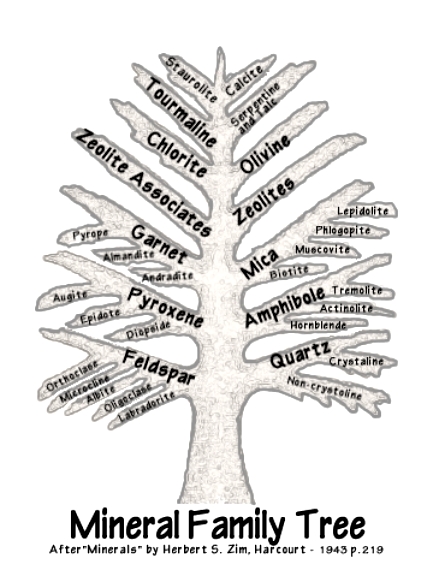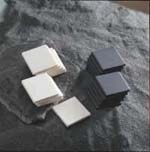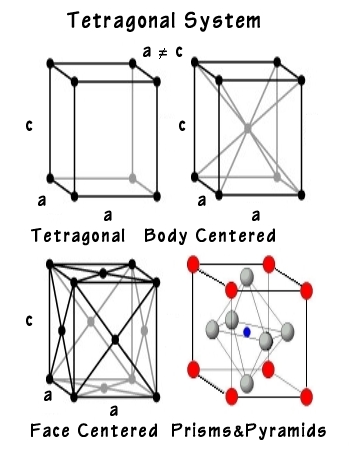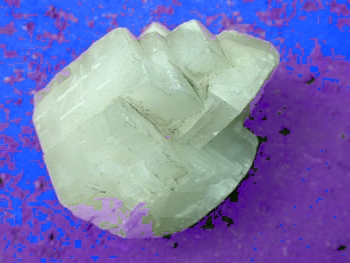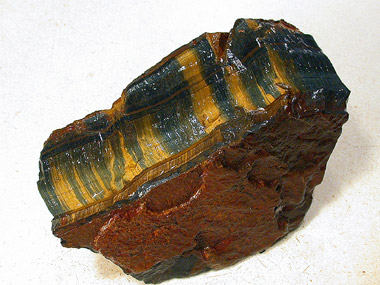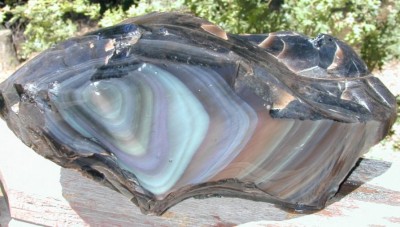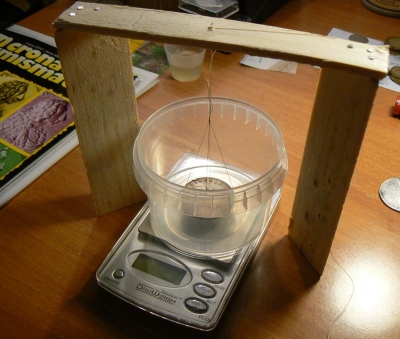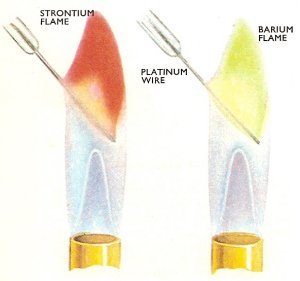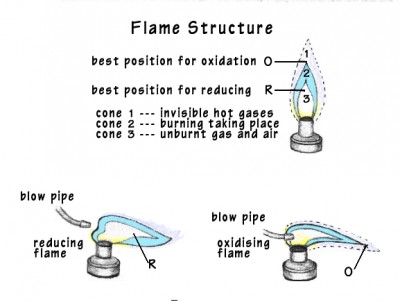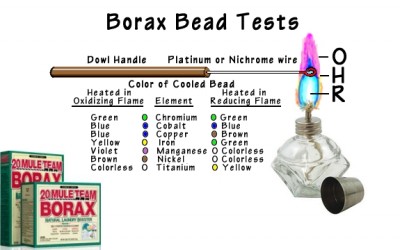Post by 1dave on Nov 22, 2013 16:37:40 GMT -5
An extension of Geology for Rockhounds.
There are 6 fairly simple Tests for Identifying rocks.
I tend to be long winded, so to skip to any of them, click on the desired item listed below.
1. Color
2. Shapes and Cleavages
3. Hardness
4. Weight - Specific Gravity
5. Acid, Base, or Salt
6. Flame Tests
And a little more complicated: Assaying Gold and Silver.
Ask an analytical rockhound how to identify rocks and he will begin by trying to tell you how rocks came to be.
If you didn't chose to skip to a specific section, now you are in for the long haul.
Most scientists believe that our universe began with just hydrogen and a little helium, but even those two are complex!
As hydrogen heats up, it's electrons are forced by an expanding "forbidden Zone" into ever larger and more bizarre orbits. This allows hydrogen to connect to other elements in many wondrous (look at snowflakes!) ways.
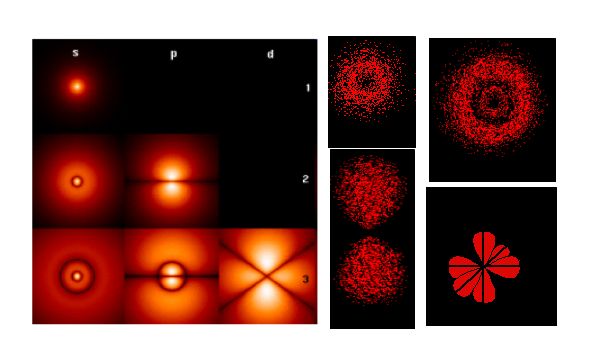
The universe is a complex place, with light elements around small stars and heavy elements radiating out at tremedous speeds from where huge stars once existed.
The different elements get heaver but SMALLER, then suddenly larger but heavier still!

The changes in size and "valences" at different temperatures and pressures prevent many element combinations from happening, and allow others that we may not have expected.
Elements between galaxies are different in abundances from those between planets in our solar system. There is a difference in abundance of the various elements between those in our atmosphere, oceans, earth core, and land surfaces.
Exploring the Periodic table.
A glance at the Periodic Table can be bewildering, but most of the rocks we will normally see are easily identified because usually there are only around 8 elements around us - with a smattering of the rest.
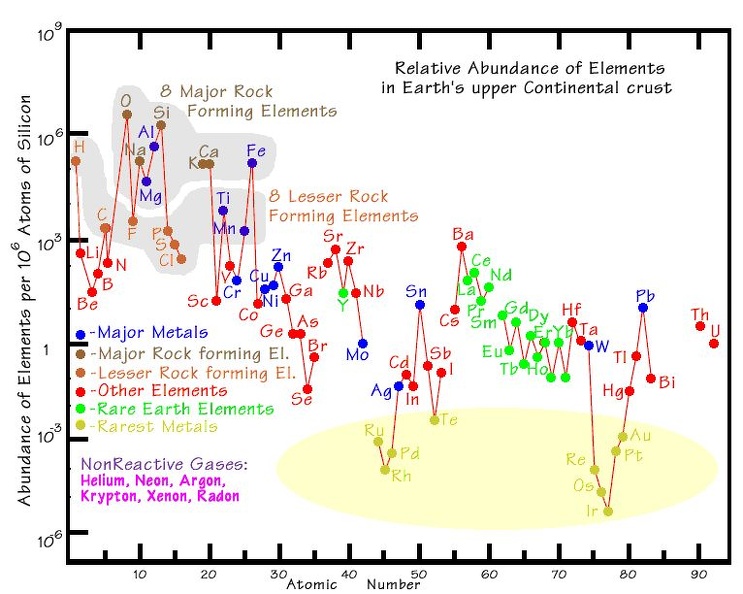
Most of our heavy elements are in the center of the earth. Really, only eight elements are commonly seen. add another eight, and unless you are in a very rare area, you can easily become familiar with most rocks. This chart will familiarize you with the elements you can expect to make up the rocks around us.
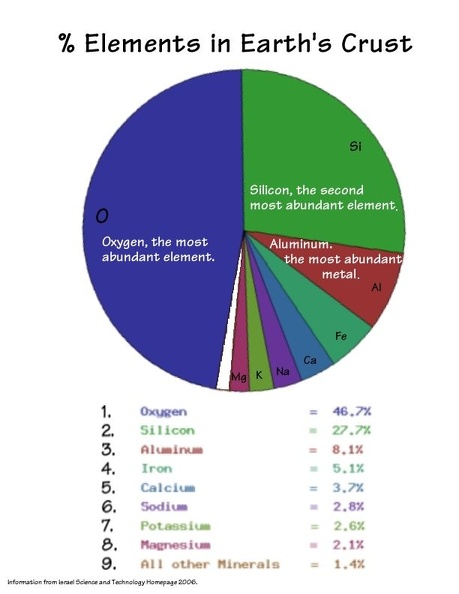
#1 Oxygen: combines with almost everything.
#2 Silica: most common rocks you will see will contain some polymorph of SiO2, usually with impurities making it beloved agate, or if enough impurities to make it opaque, Jasper.

#3 Aluminum is found in so many silicates it is impractical to name them all, but the Feldspars (field crystals) are the most common rocks on the face of our planet.
Aluminum Oxide AKA corundum, Al2O3, is the second hardest stone known. Add a little Cr and it becomes red ruby, or a little Fe and Ti and it becomes sapphire!
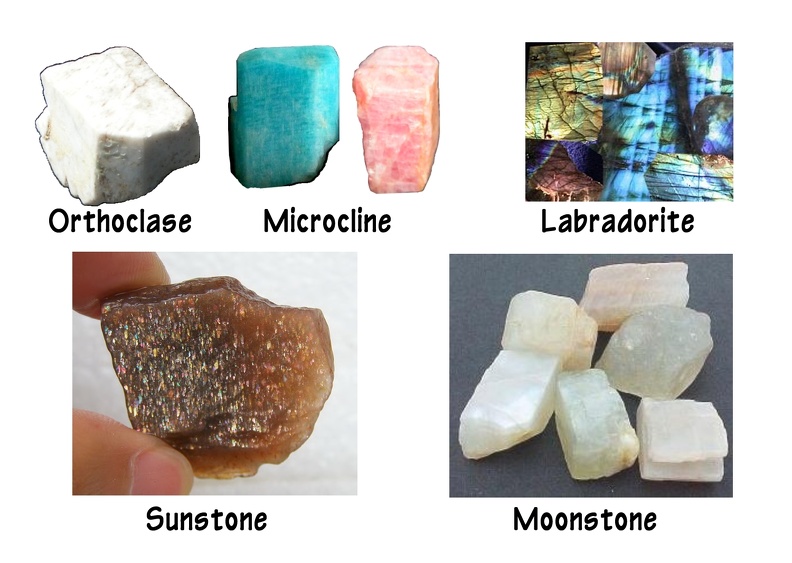
The feldspars often present a captivating aventurescence or schiller effect caused by the exchanging layers of different feldspars produced by the Endothermic - Exothermic Dance as crystallization heats magma, radiation cools it back down.
Melting adsorbs heat. Crystallization generates heat!
As the first feldspar crystallizes, it generates heat, then cools down too cool for it to form any more and stops. The next feldspar begins to crystallize and heats the magma to the point that it can no longer crystallize, but the previous one can again. In this way alternating layer after layer form, creating a diffraction grating that breaks white light into it's component colors.
#4 Iron: is common as hematite, limonite, magnetite,Siderite AKA "beerbottle ore," pyrite, goethite, . . .
#5 Calcium: is easily dissolved in water and deposited as white fillings in fractures. It is easily identified as it fizzes with a drop of vinegar or another acid.
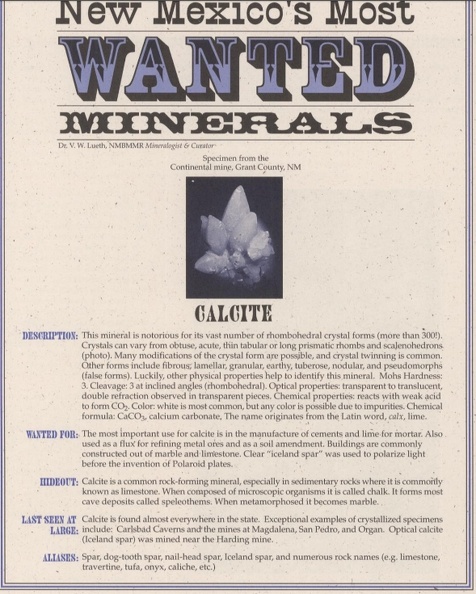
#6 Sodium: commonly attaches to chlorine - NaCl - to form table salt AKA Halite. It occurs in dry lake beds and huge salt domes. It is found in the soda feldspars, borax, jadeite, and celestite.
#7 Potassium: is found in Potash - Alum - Kalinite (used in gun powder) and the potassium feldspars, Muscovite mica.
#8 Magnesium: is found in many common rocks, Talc, olivine - peridot, pyrope garnets, magnesite, the micas biotite and phlogopite, the amphibols, the pyroxenes, serpentine, and spinel.
*******************************************************************************

Just like H2O cycling through Ice - Water - Steam - rain,
ALL ROCKS are continually cycling through three different configurations, Igneous, Metamorphic, Sediment.
 In spite of the "Global Warming Crackpots" the earth is continually getting colder! 3 billion years ago a typical volcanic eruption produced lava in the 3,000oC range. Today most are around 1,200oC.
In spite of the "Global Warming Crackpots" the earth is continually getting colder! 3 billion years ago a typical volcanic eruption produced lava in the 3,000oC range. Today most are around 1,200oC.
In addition to what elements are present, temperature has a major effect on what minerals are produced in an eruption.
FRACTIONATION comes into play as high temperature minerals crystallize and drop out, modifying the magma, making it ever more silicic. First to form is Basalt, then Andesite, and finally Granite.
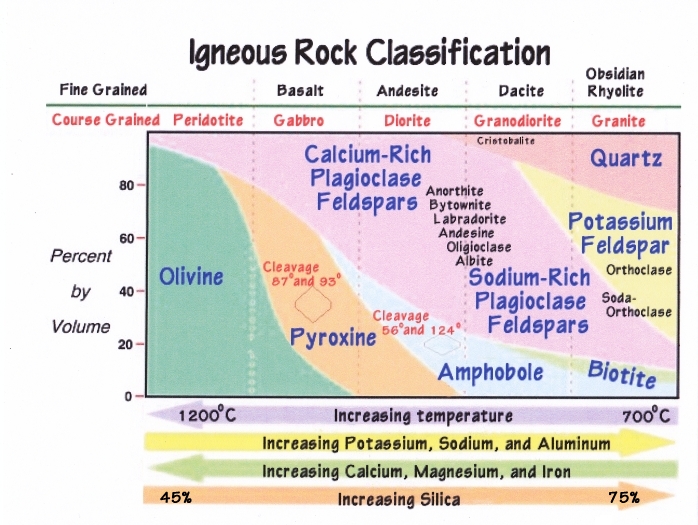
All of which are Igneous Rocks which break down into Sedimentary Rocks, both of which can be heat and pressured changed into Metamorphic Rocks.
Metamorphic Rocks are generated, - therefore FOUND - close to igneous rocks OR where continental collisions or DEEP burial has occurred.
By far the most boring of the three are Sedimentary Rocks, consisting only of sand, clay, diamonds, emeralds, fossils (the History of Life!) gold, rubies, sapphires . . .
There are 6 fairly simple Tests for Identifying rocks.
I tend to be long winded, so to skip to any of them, click on the desired item listed below.
1. Color
2. Shapes and Cleavages
3. Hardness
4. Weight - Specific Gravity
5. Acid, Base, or Salt
6. Flame Tests
And a little more complicated: Assaying Gold and Silver.
Ask an analytical rockhound how to identify rocks and he will begin by trying to tell you how rocks came to be.
If you didn't chose to skip to a specific section, now you are in for the long haul.
Most scientists believe that our universe began with just hydrogen and a little helium, but even those two are complex!
As hydrogen heats up, it's electrons are forced by an expanding "forbidden Zone" into ever larger and more bizarre orbits. This allows hydrogen to connect to other elements in many wondrous (look at snowflakes!) ways.

The universe is a complex place, with light elements around small stars and heavy elements radiating out at tremedous speeds from where huge stars once existed.
The different elements get heaver but SMALLER, then suddenly larger but heavier still!

The changes in size and "valences" at different temperatures and pressures prevent many element combinations from happening, and allow others that we may not have expected.
Elements between galaxies are different in abundances from those between planets in our solar system. There is a difference in abundance of the various elements between those in our atmosphere, oceans, earth core, and land surfaces.
Exploring the Periodic table.
A glance at the Periodic Table can be bewildering, but most of the rocks we will normally see are easily identified because usually there are only around 8 elements around us - with a smattering of the rest.

Most of our heavy elements are in the center of the earth. Really, only eight elements are commonly seen. add another eight, and unless you are in a very rare area, you can easily become familiar with most rocks. This chart will familiarize you with the elements you can expect to make up the rocks around us.

#1 Oxygen: combines with almost everything.
#2 Silica: most common rocks you will see will contain some polymorph of SiO2, usually with impurities making it beloved agate, or if enough impurities to make it opaque, Jasper.

#3 Aluminum is found in so many silicates it is impractical to name them all, but the Feldspars (field crystals) are the most common rocks on the face of our planet.
Aluminum Oxide AKA corundum, Al2O3, is the second hardest stone known. Add a little Cr and it becomes red ruby, or a little Fe and Ti and it becomes sapphire!

The feldspars often present a captivating aventurescence or schiller effect caused by the exchanging layers of different feldspars produced by the Endothermic - Exothermic Dance as crystallization heats magma, radiation cools it back down.
Melting adsorbs heat. Crystallization generates heat!
As the first feldspar crystallizes, it generates heat, then cools down too cool for it to form any more and stops. The next feldspar begins to crystallize and heats the magma to the point that it can no longer crystallize, but the previous one can again. In this way alternating layer after layer form, creating a diffraction grating that breaks white light into it's component colors.
#4 Iron: is common as hematite, limonite, magnetite,Siderite AKA "beerbottle ore," pyrite, goethite, . . .
#5 Calcium: is easily dissolved in water and deposited as white fillings in fractures. It is easily identified as it fizzes with a drop of vinegar or another acid.

#6 Sodium: commonly attaches to chlorine - NaCl - to form table salt AKA Halite. It occurs in dry lake beds and huge salt domes. It is found in the soda feldspars, borax, jadeite, and celestite.
#7 Potassium: is found in Potash - Alum - Kalinite (used in gun powder) and the potassium feldspars, Muscovite mica.
#8 Magnesium: is found in many common rocks, Talc, olivine - peridot, pyrope garnets, magnesite, the micas biotite and phlogopite, the amphibols, the pyroxenes, serpentine, and spinel.
*******************************************************************************

Just like H2O cycling through Ice - Water - Steam - rain,
ALL ROCKS are continually cycling through three different configurations, Igneous, Metamorphic, Sediment.
 In spite of the "Global Warming Crackpots" the earth is continually getting colder! 3 billion years ago a typical volcanic eruption produced lava in the 3,000oC range. Today most are around 1,200oC.
In spite of the "Global Warming Crackpots" the earth is continually getting colder! 3 billion years ago a typical volcanic eruption produced lava in the 3,000oC range. Today most are around 1,200oC.In addition to what elements are present, temperature has a major effect on what minerals are produced in an eruption.
FRACTIONATION comes into play as high temperature minerals crystallize and drop out, modifying the magma, making it ever more silicic. First to form is Basalt, then Andesite, and finally Granite.

All of which are Igneous Rocks which break down into Sedimentary Rocks, both of which can be heat and pressured changed into Metamorphic Rocks.
Metamorphic Rocks are generated, - therefore FOUND - close to igneous rocks OR where continental collisions or DEEP burial has occurred.
By far the most boring of the three are Sedimentary Rocks, consisting only of sand, clay, diamonds, emeralds, fossils (the History of Life!) gold, rubies, sapphires . . .

